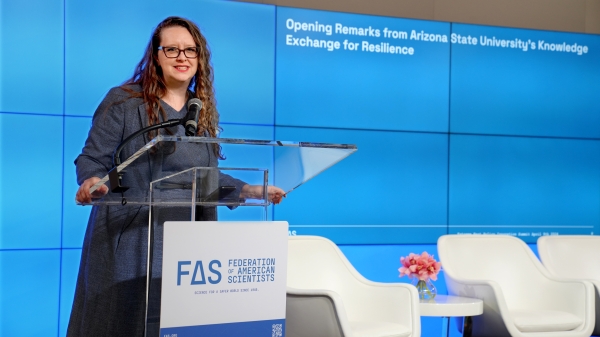Shrinking zones of habitability
ASU professors weigh in on a recent study that shows parts of the Persian Gulf region may be too hot for humans by 2100

By the end of this century, areas of the Persian Gulf could be hit by waves of heat and humidity so severe that simply being outside for several hours could threaten human life, according to a recent study.
Authors of the paper, published in the journal "Nature Climate Change," wrote that some population centers in the Middle East “are likely to experience temperature levels that are intolerable to humans” by the year 2100. Previous studies had suggested that such conditions might be reached within 200 years. But the new research, which depends on climate models that focus on regional topography and conditions, foresees a shorter timeline.
ASU climate and sustainability experts Randy CervenyCerveny is President’s Professor of Geographical Sciences and Urban Planning in the College of Liberal Arts and Sciences. He is also the Rapporteur of Weather Extremes for the World Meteorological Organization. and David HondulaHondula is an assistant research professor in the Center for Policy Informatics and the School of Geographical Sciences and Urban Planning, which is an academic unit of the College of Liberal Arts and Sciences. provide perspective on this finding.
Question: How common is it to make these measurements with the wet bulb readings?
Randy Cerveny: "Wet bulb temperature" is one of the ways that we have of tracking humidity. Here in the U.S., we tend to use relative humidity and dew point more often that WBT. High wet bulb temperatures correspond to high dew points. We have long known that some of the highest humidities — dew points in the 90s — occur on the Persian Gulf coast, but there aren't a lot of consistent good humidity measurements taken around the world. So we at the World Meteorological Organization do not yet recognize any locations as having the global world record for highest humidity.
Q: Is this a new finding? Are out door activities going to be hazardous to our health in these areas?
David Hondula: We have a lot of evidence and confidence that heat is going to be a major game-changer for certain locations, populations, lifestyles and activities. I would say that this is a different lens to look at an ongoing theme in sustainability and public health literature. I appreciate that the paper illustrates a large-scale outdoor activity that occurs in this part of the worldThe Hajj - the annual Islamic pilgrimage to the holy city of Mecca, in Saudi Arabia. Approximately 2 million people make the journey each year. that is one of those particularly high-interest and high-impact cases. But in no way is this ritual "likely to become hazardous to human health" — it already is. Epidemiological investigations of the pilgrimage during a previous warm-season cycle revealed hundreds of cases of heat stroke and even cite "mass causalities" related to heat exposure during the pilgrimages of the middle of the 20th century.
Q: How quickly has it become the case that an entire region may not be habitable?
Hondula: Conditions already exist in many parts of the globe — including here in central Arizona — where environmental conditions regularly exceed the physiological limits of the human body, especially when sunlight, hydration status, workload and clothing are all considered. On the other side of the weather spectrum, we have large populations in cities all across the globe where outdoor wintertime conditions would lead to illness and/or death with exposure times on the order of hours. So we are already dealing with "inhabitability" in certain doses today. Could it be the case that the zones of habitability shrink in the future, and/or challenge some of the world's major population centers? Certainly. And these changes could come more quickly than we are able to respond to, physiologically, culturally and/or technologically. But dealing with extreme environmental conditions has been part of the human experience for perhaps the species' entire existence.
Q: As a practical matter, what does it mean that you can’t live there? What happens to the people who decide to stay?
Hondula: Physiological adaptationA process known as acclimatization. is only one of the mechanisms by which people can adjust to or cope with thermal extremes. It is the one emphasized in the paper. Behaviors and technology play important roles, too. The authors touch on this idea with the reference to the potential for air conditioning use, which has been attributed by some researchers to the multi-decade declines in heat-related mortality seen in many developed countries across the world. Of course access to air conditioning may not be a feasible solution for this region or some of its inhabitants, for whom it would be important to understand the thermal conditions of homes, workplaces and recreational sites where they spend their time. It may be the case that design principles have been successfully leveraged to mitigate environmental exposures, or that indoor and experienced conditions are actually worse than we would suspect based on model projections alone. I think the authors were wise to choose "a threshold," in their title, as we are, in my opinion, a long ways off from understanding the thresholds for habitability.
Q: Whether it’s heat and humidity or something else, what areas are likely in the crosshairs for a radical change in way-of-life because of climate change?
Cerveny: Coastal areas. With rising sea levels and higher amounts of rainfall, coastal areas — specially islands — are likely one of the areas of greatest change in the next few decades.
More Environment and sustainability

Arizona adapting to heat crisis with initiatives featured in ASU report
Arizona State University's Knowledge Exchange for Resilience, also known as KER, released its Recommendations Report on Extreme Heat Preparedness earlier this April during a summit in the nation's…

Celebrating Earth Day around the world
Originating in the United States in 1970, Earth Day is now celebrated worldwide. But even before it became an official day, many countries were already mindful of their carbon footprint in their…

A run on fossil fuels: ASU professor says climate legislation could have unintended consequences
As concerns about climate change grow, policymakers are increasingly voicing support for stricter fossil fuel legislation. Their discussions and proposals raise questions about the future of the oil…